
In an era where video sharing platforms dominate digital media consumption, industry giants like YouTube and TikTok are more than just platforms for entertainment; they are gateways to information, culture, and opinion, shaping our perception of the world with every swipe and click.
These platforms are dynamic ecosystems where videos are curated, recommended, and shared based on very complex (and secretive) algorithms. We know that once you start watching content, the algorithm will automatically recommend related videos. However, this technological sophistication brings with it questions of bias and fairness: what content does the algorithm recommend when it doesn’t have prior information about your interests? Are these platforms truly neutral or do underlying biases influence the content they prioritize?
By analyzing content trends across different countries, this research seeks to provide a nuanced understanding of how YouTube and TikTok may favor certain narratives, ideologies, or commercial interests in various regions. Ultimately, we aim to uncover potential biases behind these video sharing platforms and understand their implications.
Our goal is not to point fingers but to shed light on how global audiences are served content, fostering awareness about the algorithms that shape our digital experiences. Through this exploration, we hope to contribute to the ongoing conversation about the role of video sharing platforms in our daily lives and their impact on global culture and politics.
YouTube and TikTok’s Recommendations for New Users: Methodology Overview
For this research, we took a close look at YouTube and TikTok across 24 countries:
- Argentina
- Australia
- Brazil
- Canada
- Egypt
- France
- Germany
- Israel
- Italy
- Japan
- Korea
- Mexico
- Morocco
- Netherlands
- Philippines
- Saudi Arabia
- Singapore
- South Africa
- Spain
- Turkey
- UAE
- UK
- USA
- Venezuela
We selected at least one country per continent, trying to include different cultures to understand potential differences. The reason why we chose to focus on YouTube and TikTok is because they are two of the most popular video sharing platforms worldwide. Our main goal was to see what kind of content these platforms put on display for new users. This includes checking for any political bias, racial diversity, content themes, and advertising (both the ads that are easy to spot and the ones that aren’t).
By looking at what new users are shown, we can try to figure out the platforms’ strategies to engage viewers. How do they try to hook new visitors? What kind of videos do they think will make you stick around? More than us being curious (which we were), this research project is about understanding how YouTube and TikTok might be guiding us toward certain videos and, consequently, what they think is important or appealing to viewers around the globe.
Here’s how we did it:
- We used a virtual private network (VPN) to connect to a server located in one of the selected countries.
- Then, we visited YouTube and TikTok without logging into the platforms. By doing this, we wanted to see what each one recommends when it doesn’t have any of your past likes or views to guide it — just your country and the device you’re using.
- We watched the first 100 videos suggested on each platform and noted down relevant data regarding their content.
- We repeated steps 1-3 for each of the above-mentioned 24 countries. It took us a month (from the end of January to the end of February 2024) to gather all the data.
Interestingly, right after we wrapped up our research, YouTube stopped showing any recommendations to users who aren’t logged in. Now, to see anything, you have to search for something first — that is, you need to give the algorithm a hint about what you’re interested in before it shows you any of the available videos.
We conducted similar tests using the ‘Trending’ section within the ‘Explore’ feature on YouTube’s homepage to assess the impact of this update on our findings. Without engaging with the algorithm, we found recommendations remained largely consistent, albeit presented in the regular YouTube result page format instead of the previous grid layout of thumbnails and titles. Consequently, our results remain entirely valid post-update.
This update is a game-changer because it means new visitors have to start interacting with the platform to get any content suggestions. It’s an interesting twist that came just as we finished our study, adding another layer to how we understand these platforms’ approach to drawing in and engaging new users.
Key Discoveries on Global Content Variations for New Users on YouTube and TikTok
Our researchers analyzed what new YouTube and TikTok viewers get as initial video recommendations in a variety of countries around the world. Here’s a snapshot of our key findings, highlighting how content varies across the globe and what it says about these platforms:
- Content varies by country: Across the board, we noticed that people in various countries see different kinds of videos. What’s popular in one country might not be in another, showing how these platforms tailor content to regional tastes and interests.
- Diversity representation varies by country: There’s a noticeable difference in the content served across countries in terms of diversity. While some countries’ (such as the United Arab Emirates and Singapore) top 100 videos show people from various races and genders, other countries (like Morocco and Italy) show a clear tendency towards certain ethnicities.
- Ideological leanings vary by country: Our analysis found that some countries (like the US) receive more right-leaning content whereas others (such as Germany and Canada) are shown content with a left-wing trend. This variation underscores the platforms’ role in shaping political discourse, though it’s worth mentioning that neither platform particularly favors political content in general for new users.
- Advertisement and promotion frequency vary by country: Some countries (like Germany and Australia) see more advertisements and sponsored posts. There’s also a significant presence of unofficial or unmarked product placements and promotions, with some countries (such as Mexico and Singapore) experiencing this more than others.
Top Content Themes Worldwide: What Do New Users See?
For this research, we looked at a total of 4,800 videos on YouTube and TikTok to find out what themes are most popular worldwide. We focused on how often different themes appeared in the top 100 recommended videos across the 24 countries we studied.
Some videos focused on just one theme, whereas others seemed to encompass two or three themes at a time. This means that if we add up the percentages for each theme, the sum will exceed 100%.
Top Themes on YouTube
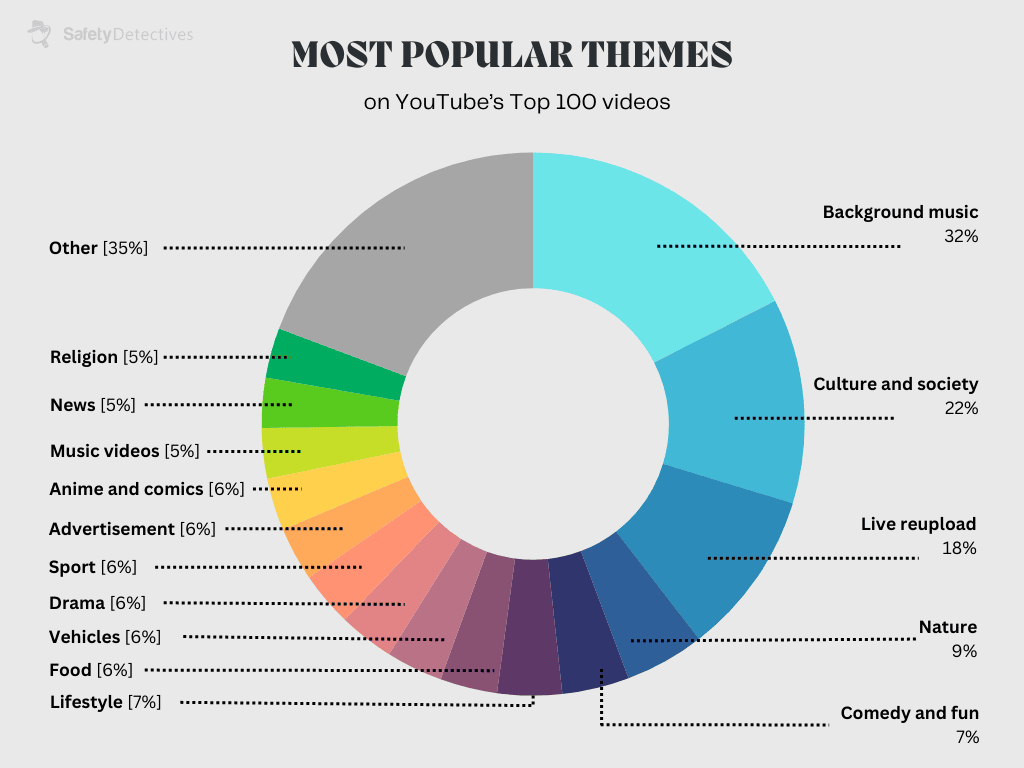
YouTube introduces new viewers to a variety of themes, though Background music is the most common by far, with nearly a third of all 2,400 videos corresponding with this category. This suggests that YouTube’s algorithm recognizes a universal appeal for music as both a primary focus and as ambient background to other activities.
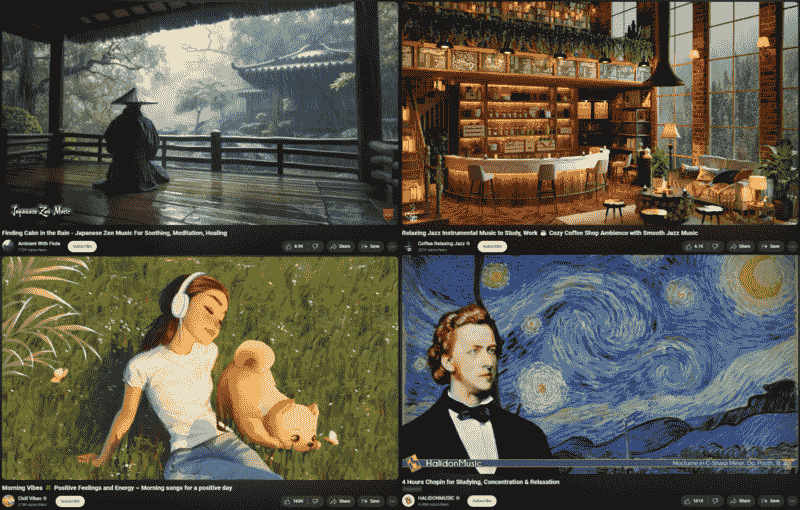
YouTube highlights music that sets the mood and/or keeps viewers engaged.
Culture and society themes are also pretty big on YouTube, making up 22% of the content visibly available for new users. This suggests an algorithmic assumption that content related to current events holds broad interest — especially when we consider how themes such as News also feature among the platform’s popular categories. By prioritizing these themes, YouTube presumably aims to position itself as a key resource for updates on global happenings, appealing to users’ desire to be informed and engaged with societal issues.
Themes like Nature (9%) and Lifestyle (7%) are not as popular as the previously broached categories, but they’re still fairly prominent. Highlighting these areas suggests an intent to draw in users by tapping into the wide spectrum of personal interests and aspirations. These themes can offer both escapism and insights into daily life, appealing to a wide audience seeking either relaxation or actionable advice.
Top Themes on TikTok
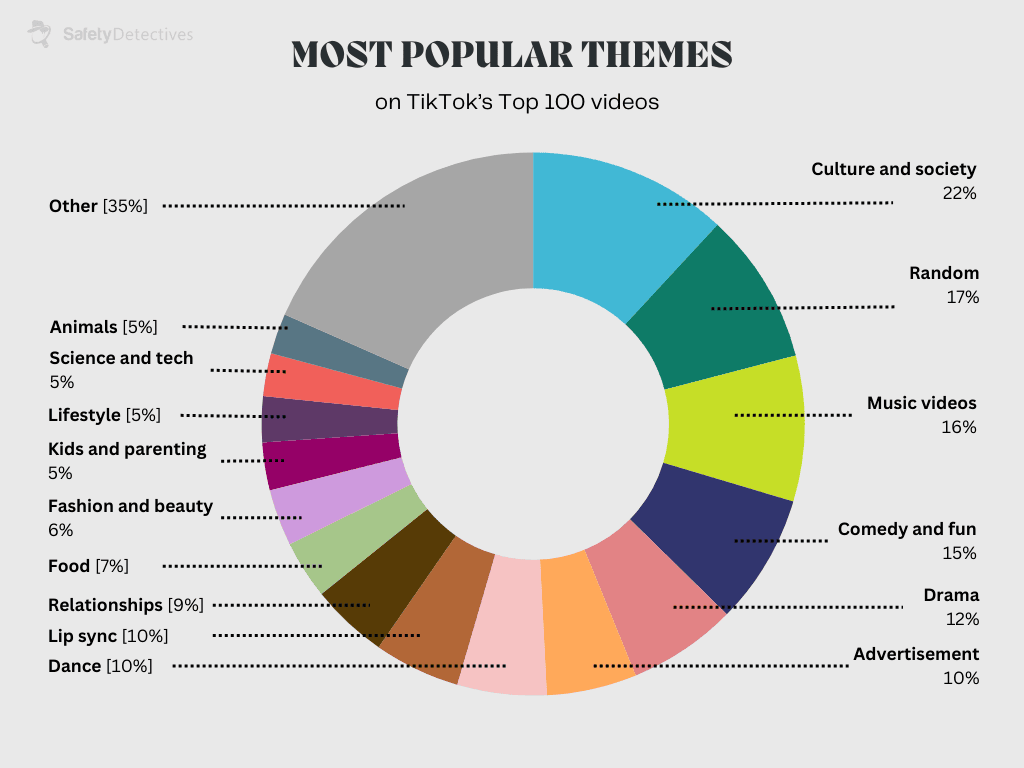
TikTok, with its brief video format, doesn’t really focus on Background music — although music does feature in many of its videos. Instead, it gears toward quick, engaging entertainment that frequently encourages viewer interaction. This is easily exemplified by the prevalence of Music (16%), Comedy (15%), Drama (12%), Dance (10%), and Lip sync (10%) videos.
That said, Universal Music Group’s recent removal of its songs from TikTok — which went into effect right as we were conducting our research — will probably reshape the platform’s content strategy. This change challenges TikTok’s dependency on music to drive engagement and could shift the focus of popular video themes. Perhaps TikTok will find new musical sources to keep users engaged, or perhaps it will adapt by diversifying its content.
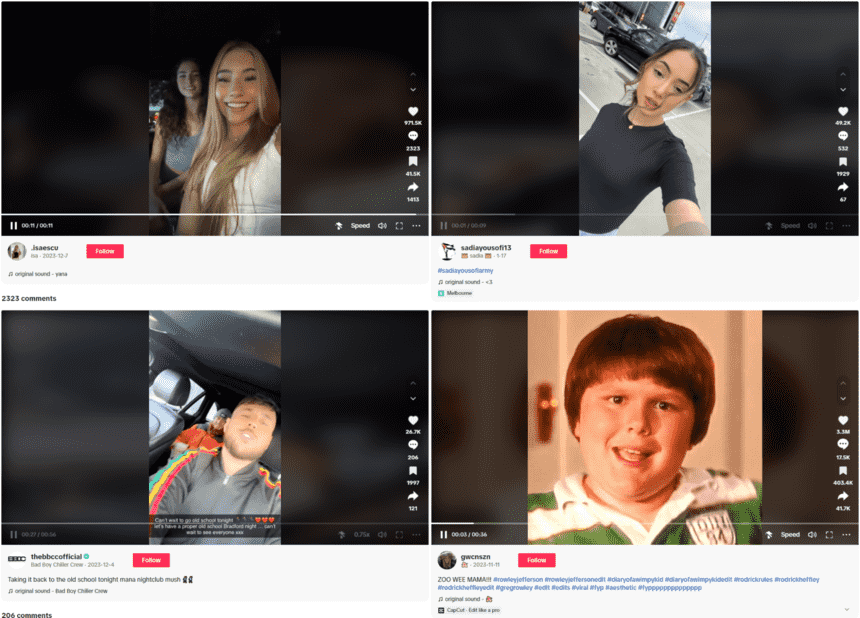
TikTok’s algorithm favors lip sync videos, emphasizing user interaction and trend participation
The popularity of some of the themes — like Fashion and beauty, for example — highlights TikTok’s focus on personal expression and identity. Its algorithm seems finely tuned to surface content that encourages participation, self-representation, and engagement.
Ultimately, though, Culture and society is the platform’s most common theme among its top 100 videos, being just as prevalent as it is on YouTube.
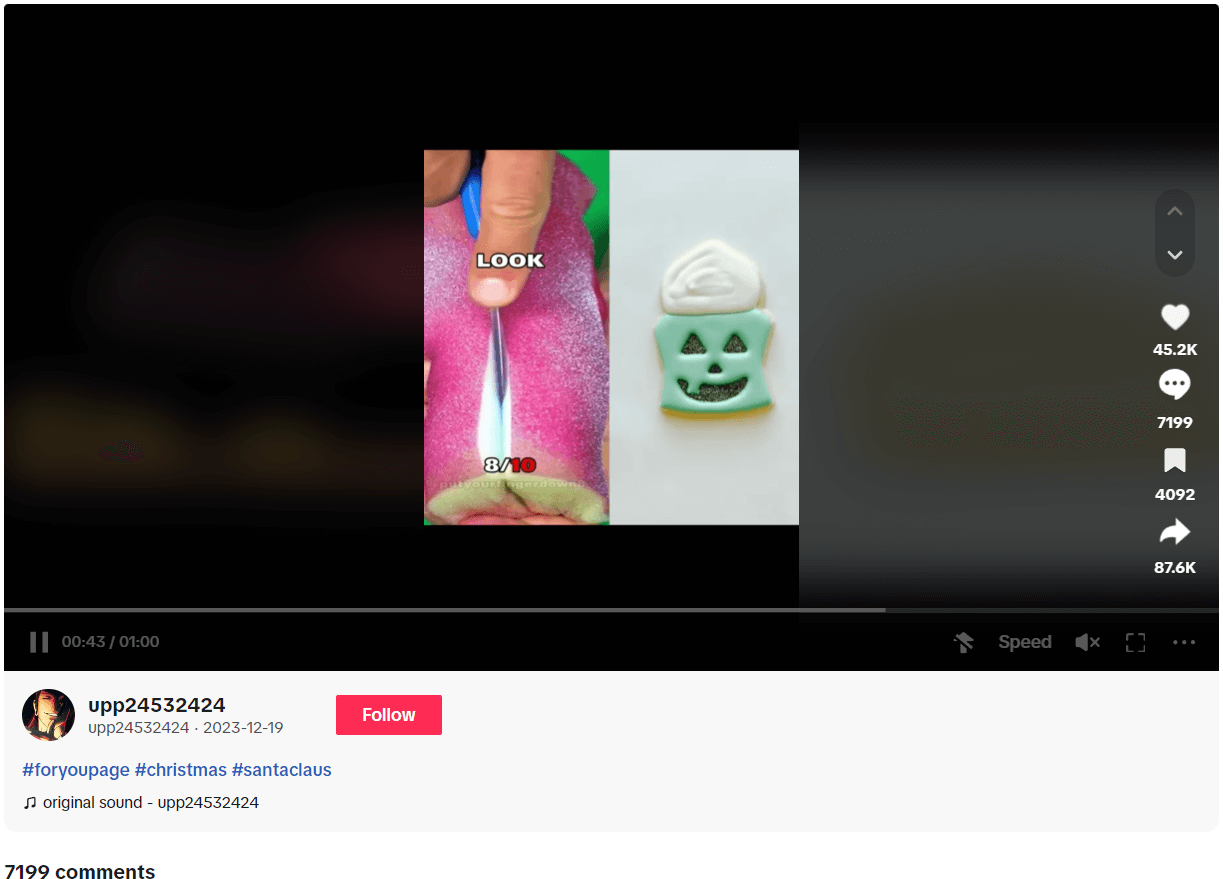
Example of a TikTok video encouraging viewers to participate by doing a “pretty test”.
Finally, it’s worth noting that TikTok has four times more videos unofficially promoting a product or service than YouTube — that is, videos featuring product placements or indirect recommendations. However, it’s important to clarify that our research did not include TikTok Shop, as this feature is available only to logged-in users, who are more likely to see significantly more official promotional videos than new users without an account.
Common Themes: A Quick Overview
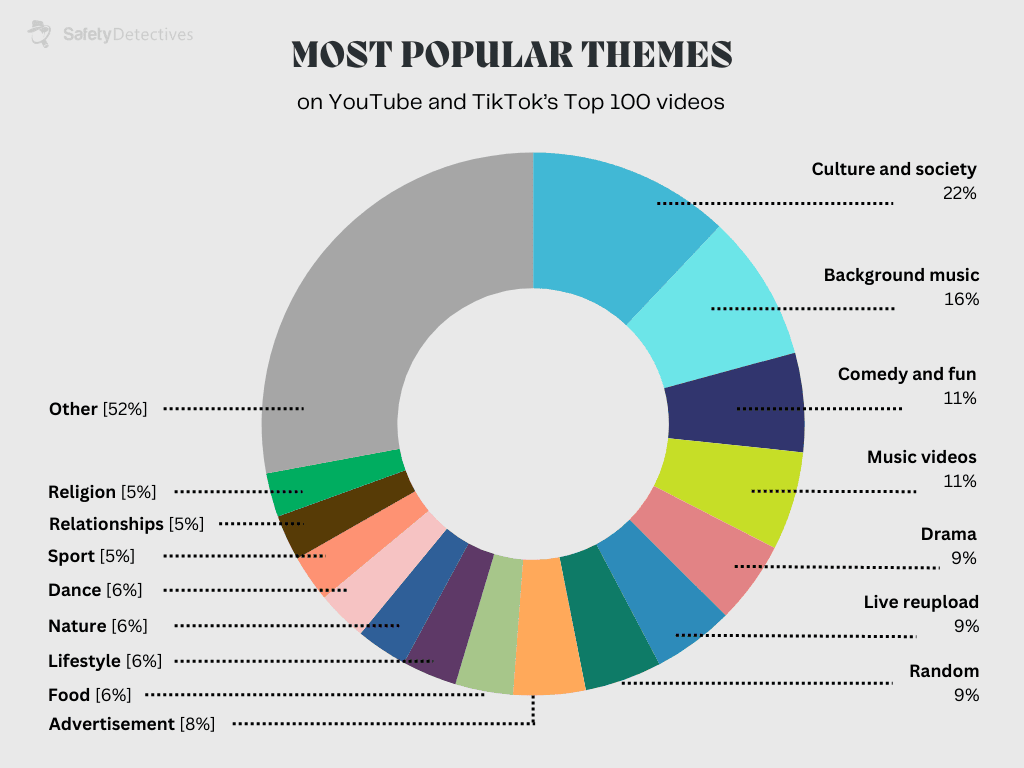
The shared popularity of themes like Culture and society (22%), Comedy and fun (11%), and Drama (9%) across both platforms suggests a universal appeal for content that reflects societal norms, issues, and storytelling. This indicates both platforms’ algorithms are adept at highlighting content that resonates on a human level, though they rely on different formats and engagement styles.
The distinctions in popular themes, on the other hand, hint at YouTube positioning itself as a platform for both active and passive engagement — users might want to catch up on the news, or they might want to passively listen to music in the background. TikTok, by contrast, seems to encourage more active, immediate engagement, with its content designed for quick consumption and viewer participation.
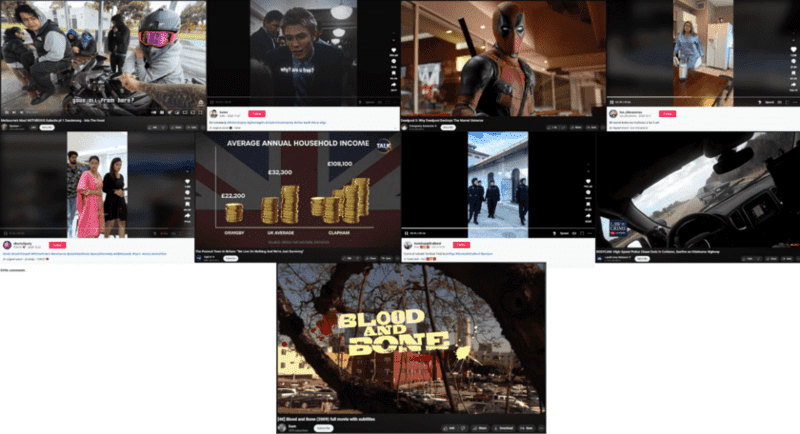
Both YouTube and TikTok favor themes reflecting universal stories and societal themes
Top Content Themes by World Region
We also explored recurring themes on both platforms across different regions. By comparing the themes that feature more often in various countries’ top 100 videos, we can suss out not only the universal appeal of certain themes but also the distinct cultural nuances that YouTube and TikTok aim to cater to in each region.
Top Themes by Region on YouTube
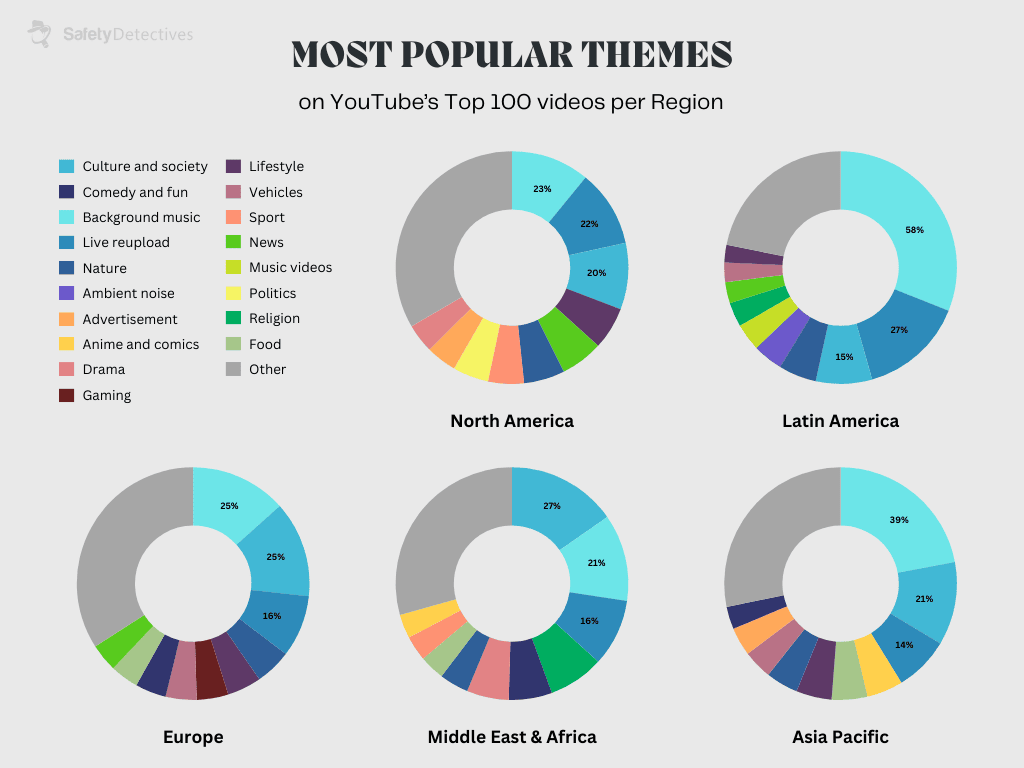
YouTube’s algorithm seems to prioritize the same three themes across all regions: Background music, Culture and society, and Live reupload. The popularity of cultural and social content suggests an attempt by YouTube to appeal to a broad, globally aware audience right from the start. Similarly, the popularity of Live reupload content highlights YouTube’s effort to connect new users with previously aired live events, suggesting the value placed on inclusivity in shared cultural and entertainment experiences.
That said, there are some clear differences between regions. For instance, Gaming content ranks much higher in Europe than in any other region, featuring in over 8% of the region’s top videos. The same is true for Politics (10.5%) in North America, Ambient noise (8%) in Latin America, and Anime and comics (9%) in the Asia Pacific region.
Top Themes by Region on TikTok
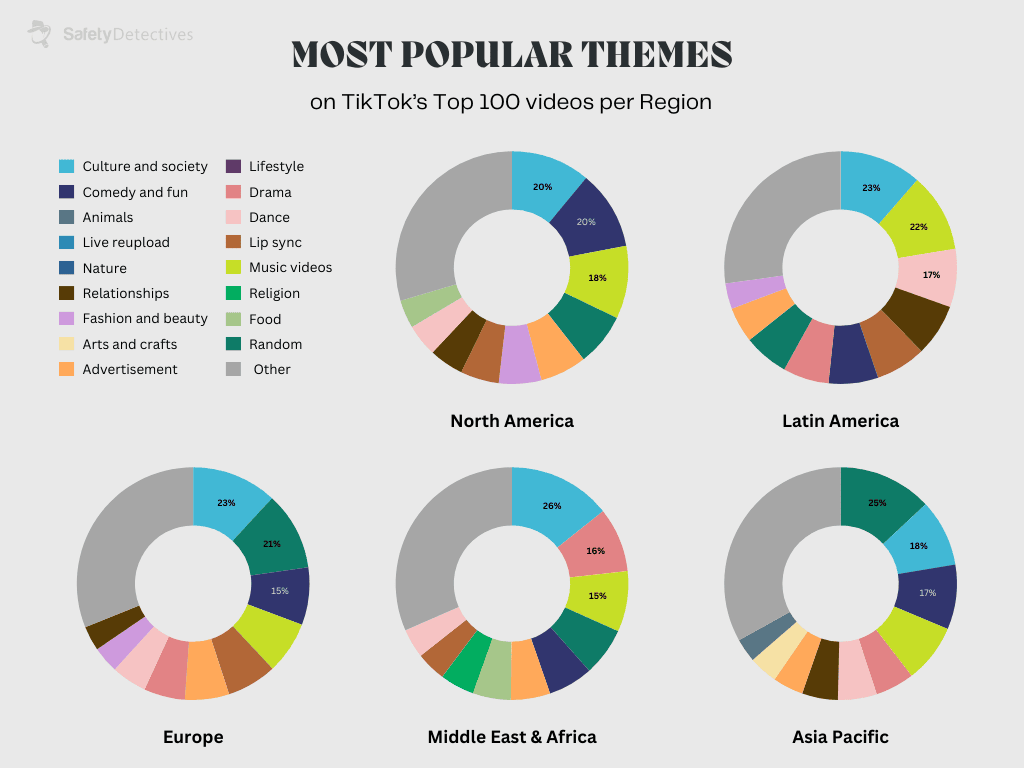
Culture and society is practically the most popular theme across every region when it comes to TikTok’s top 100 picks for new users. This indicates a global interest in content that reflects societal norms and cultural narratives, with TikTok placing a significant emphasis on these themes to engage new users from diverse backgrounds.
Music videos consistently emerge as a favorite too, underlining its universal appeal as a core element of TikTok’s content strategy. Drama and Comedy are also popular in most regions, revealing a strong preference for narrative-driven content that may reflect localized storytelling traditions and social dynamics.
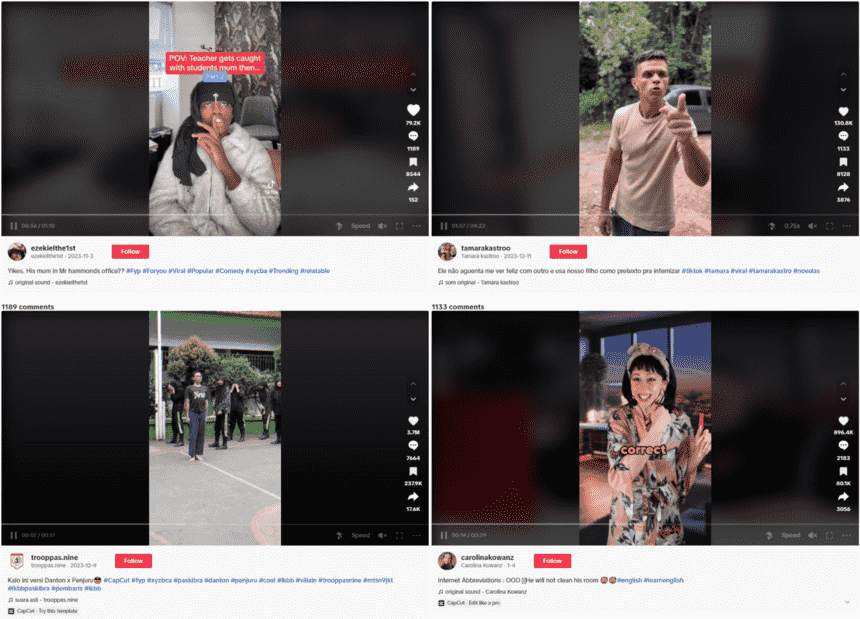
TikTok highlights content that showcases the global love for storytelling.
However, as on YouTube, there are some notable differences across the regions. For instance, North America’s marked preference for Food content is only surpassed by the Middle East and Africa, where 10% of the region’s videos are related to that topic. Similarly, new Asia Pacific users are shown substantially more videos about Animals (6%) and Crafts (7%) than viewers from other regions. For comparison, the Middle East and Africa is the only region where Religion made it to the top 10 themes, featuring in roughly 9% of the videos.
Common Themes per Region
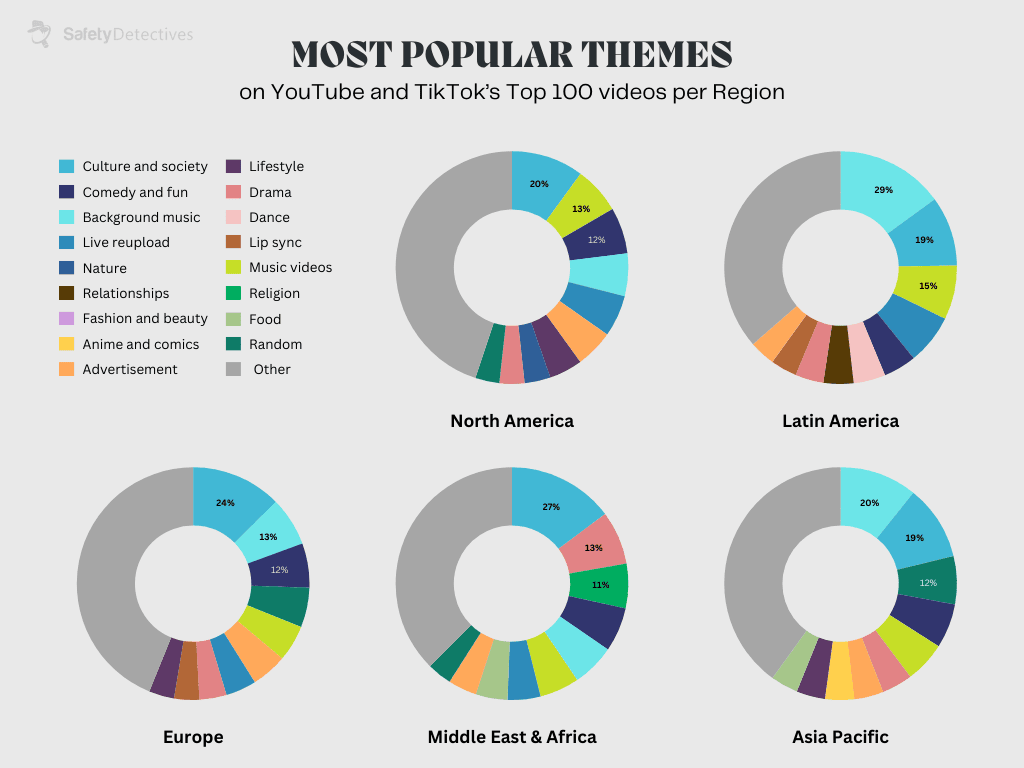
Certain themes that were popular on TikTok seemed to be missing from YouTube’s top picks, such as Dance, Lip Sync, and Fashion and beauty. This highlights TikTok’s inherently participatory nature, where users are encouraged to not just watch content but to actively replicate the videos. The fact that certain themes that were popular on YouTube — such as News and Sports — are also absent from TikTok’s top themes seems to support this theory.
Ultimately, despite the differences between platforms and cultures, the top themes per region seem to be quite similar among one another. There are a few distinct preferences, made evident by certain themes hitting the top 10 in only one specific region. For instance, Latin America is the only region where Dance and Relationships made it to the final list of most popular themes, featuring in 8% of the videos each. Similarly, Religion (11%) was the fourth most popular theme in the Middle East and Africa, though it wasn’t nearly as popular anywhere else. The same thing happened with Anime and comics, though at a smaller scale (7%), in the Asia Pacific region.
Exploring Political Bias on YouTube and TikTok: Left or Right?
When exploring the political content displayed to new users on YouTube and TikTok, it’s important to consider the criteria for judging political bias. We categorized content as having a political bias based on the expression of left- or right-leaning opinions rather than the impartial reporting of facts. We also need to acknowledge the challenge of applying Western perspectives on left and right politics to non-Western countries, where political spectrums can differ significantly.
Despite the complexity of assessing political bias, we noticed some clear trends showing more left-leaning or right-leaning content in certain countries. By examining these patterns, we can gain insights into how digital platforms may play a part in influencing the political landscape in different regions.
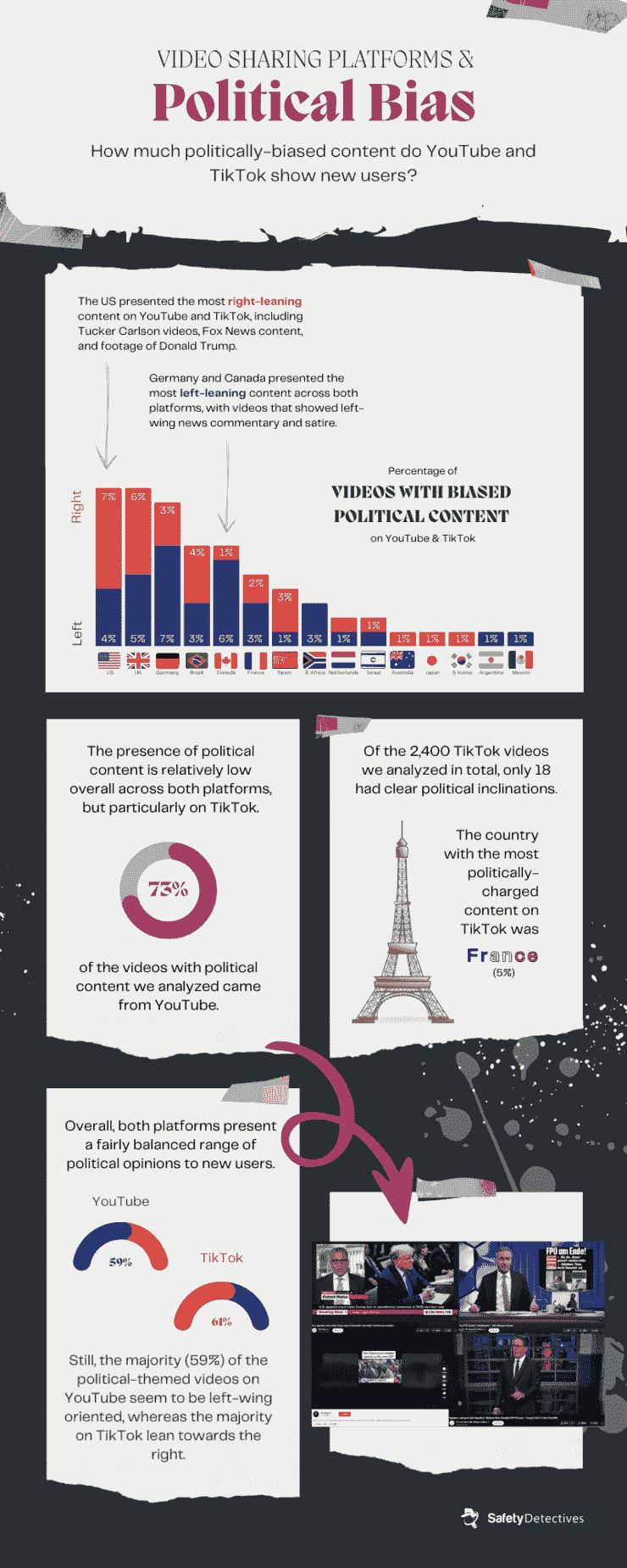
Both platforms show a variation in political bias across different countries, though the overall percentage of videos with political content remains low. Interestingly, it seems each platform targets different countries for political content. While new users from countries such as the US and the UK get politically charged videos on both platforms, other countries just get it from one of them. For instance, all of the videos with political bias (both left and right) shown to new users in Brazil, Canada, and South Africa came from YouTube, whereas all of the politically inclined videos shown to new users in Argentina, France, Japan, Mexico, and South Korea were from TikTok.
Still, TikTok’s strategy appears to largely steer clear of political content for new users, with France being an exception. This approach might be aimed at fostering a neutral, inclusive environment for user engagement, especially considering the platform’s focus on entertainment and creativity over political discourse.
YouTube, on the other hand, seems to favor political content a bit more. This suggests a careful curation of content to ensure a diverse range of political opinions are presented, although in a limited manner. The higher presence of left political bias in countries like Germany and Canada, compared to right bias, could reflect the political landscape or content preferences of users in these regions.
How Much Diversity Do New Users See on YouTube and TikTok?
Although people from different countries may have diverse backgrounds, it doesn’t necessarily follow that the content they access reflects this diversity. While conducting this study, we also wanted to analyze who featured in the videos we were shown: What do the people in the videos look like? Does that look vary across countries? Is there a perceivable bias towards certain genders, races, or ethnicities?
Female Representation
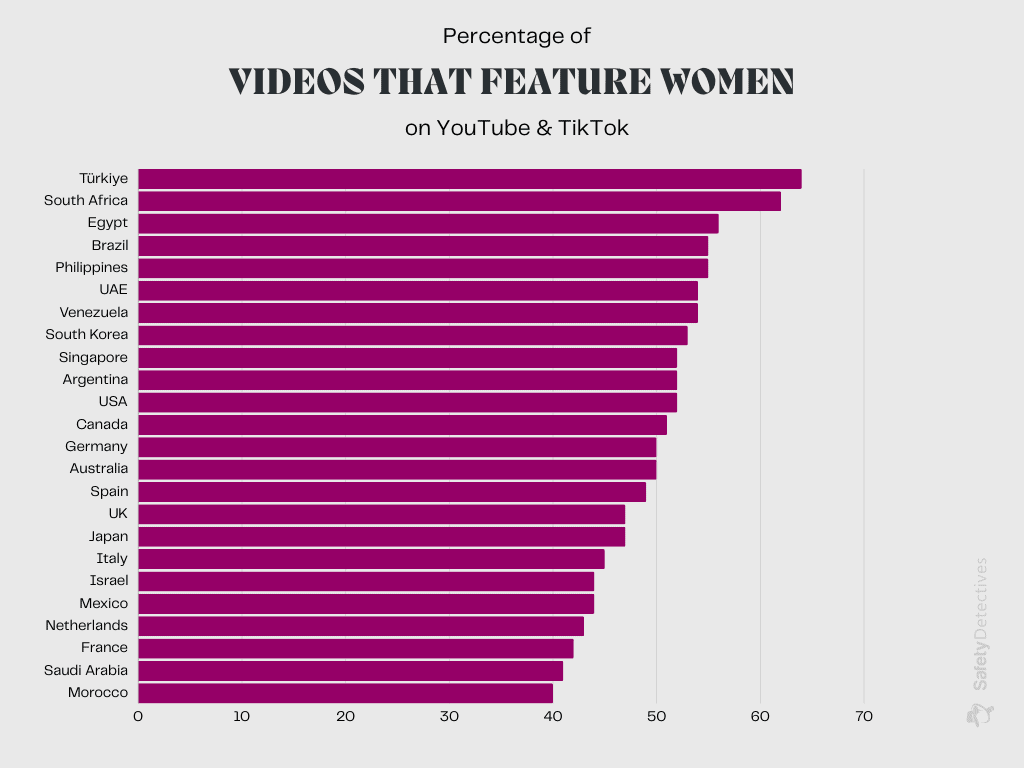
Türkiye leads our list of countries with the highest percentage of videos featuring women, coming at 64%, closely followed by South Africa (62%). The significant female representation in content recommended to new users in these regions is perhaps indicative of cultural preferences. Alternatively, it could be the platforms’ strategies to promote diversity and inclusivity in content.
In general terms, none of the countries we analyzed showcased a severe lack of female representation. In fact, only 10 of the 24 nations in our list fell below the 50% mark — that is, overall, more than half of the recommended videos on TikTok and YouTube did not feature a woman or a girl. Morocco was the country with the lowest percentage of videos with female presence (40%); for comparison, 77% of its videos featured at least one boy or man.
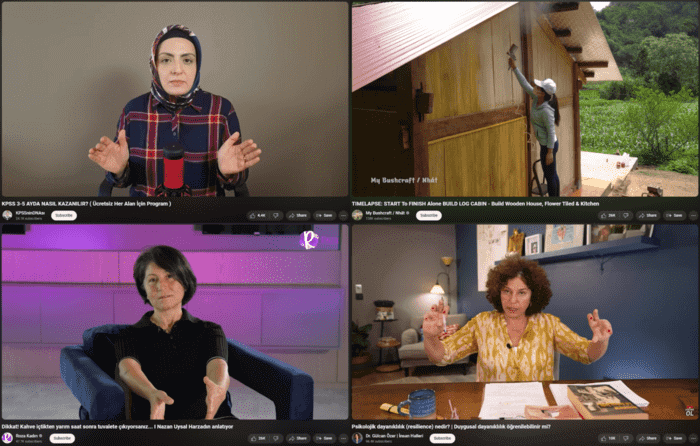
Examples of female-fronted videos shown to first-time YouTube users in Turkey.
Please note that our analysis of female representation across countries included both all-female videos and mixed-gender videos. For instance, a total of 128 Turkish videos featured women or girls — 66 on YouTube and 62 on TikTok. However, only nine of those 66 were female-only, while the remaining 54 included both men and women. Similarly, over 60% of those 62 TikTok videos were mixed-gender.
Ethnic Diversity
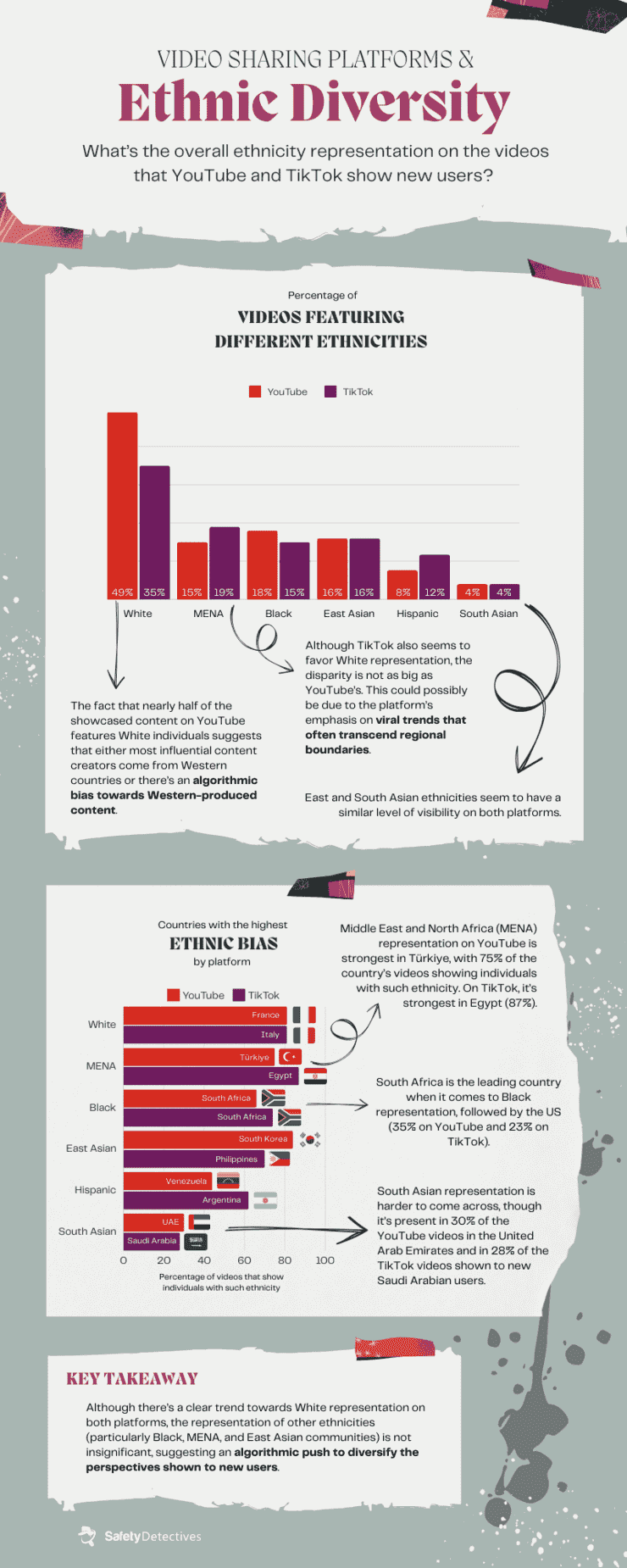
There’s no one country that represents all the ethnicities we considered for this analysis evenly, but some countries certainly showcase videos with more ethnically diverse individuals than others. Let’s take the UAE, for example: 189 of the 200 videos we watched for that country featured people. Now, 26% of those videos included people from the Middle East and North Africa (MENA), 23% showed South Asian individuals, 22% featured white people, and the remaining 29% were evenly split between East Asian and Black persons. In other words, the UAE had the most ethnic diversity out of all the countries in our list.
For comparison, 77% of the videos prioritized in Italy (across both platforms) feature white people. The remaining few portray Black (14%), East Asian (5%), MENA (2%), and South Asian (2%) individuals. In other words, non-white individuals are rarely shown to new Italian users on either platform. Something similar happens in Egypt, where the vast majority of videos (70%) portray MENA individuals.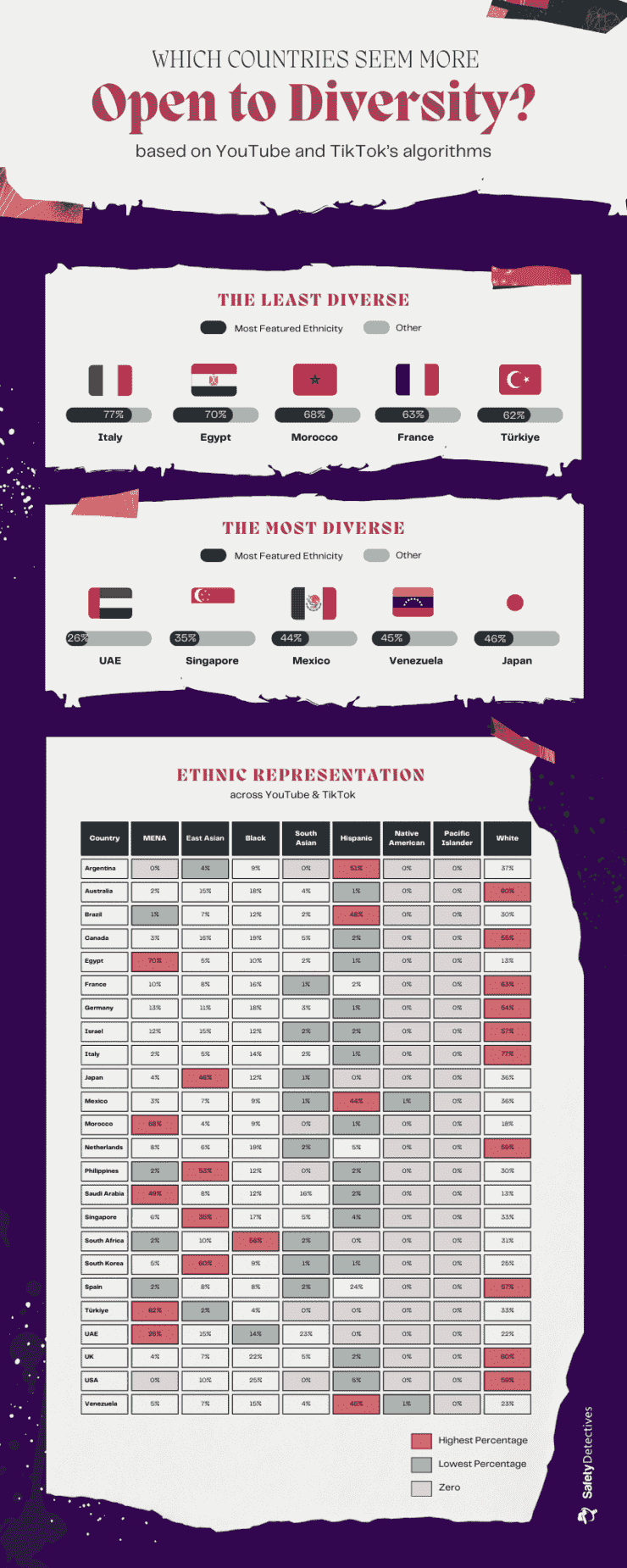
How Many Sponsored Videos & Ads Do New Users See on YouTube and TikTok?
Promotional content is pervasive across both platforms, although it may not seem like it at first glance. Only six of the countries in our list (Germany, Canada, Philippines, UK, the Netherlands, and the US) have videos marked as “promotional content” among its Top 100 TikTok recommendations for new users — and it’s only one or two videos each. Similarly, less than 1% the 2,400 TikTok videos we analyzed were marked as “paid commission”. This indicates a platform-wide approach of minimal overt advertising to viewers who aren’t logged in. However, all countries have videos that make recommendations or have product placements, even if they are not explicitly marked as advertisements or promotions.
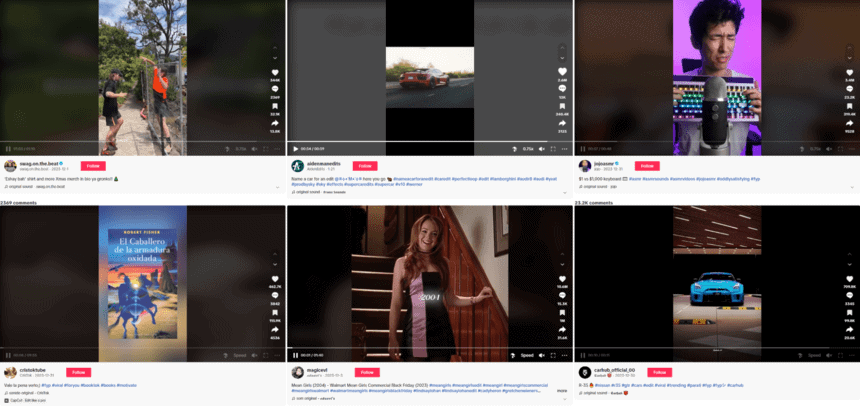
Videos from Mexico and Australia highlight TikTok’s strategy of blending promotional messages with regular content.
Something similar happens in YouTube, where all the countries on our list have at least one video with unmarked sponsored content. Unlike TikTok though, YouTube also tends to display ads before or during a video, which may be unrelated to the video’s main content. Some of these ads can be skipped by the viewer while others cannot, exposing the user to promotional content even when the video they chose to watch does not technically include any.
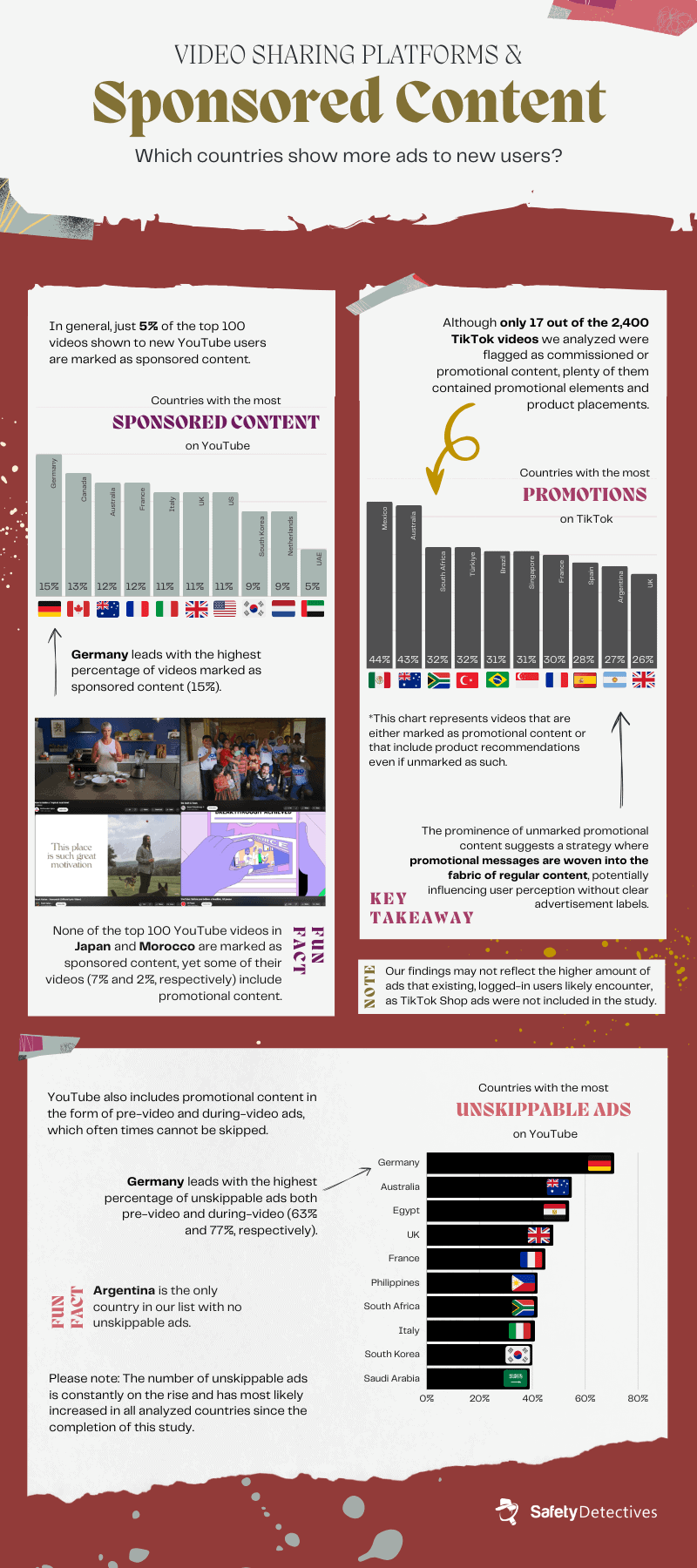
So, How Biased Are Video Sharing Platforms in 2024?
As evident in this research, video-sharing platforms are not neutral but are influenced by underlying biases that favor certain narratives, ideologies, and commercial interests. This has implications for global culture and politics, as these platforms play a significant role in shaping how global audiences perceive the world.
Key findings include:
- Content curation varies significantly by country, reflecting tailored approaches to regional tastes and interests.
- There is a noticeable difference in diversity representation and ideological leanings across countries, indicating the platforms’ role in shaping political and societal discourse.
- Advertisement and promotion frequency also varies, with some countries experiencing more unmarked product placements and promotions.
When it comes to theme prevalence, YouTube’s algorithm showcases a diverse array of themes, catering to a variety of user interests from passive listening (i.e., Background music) to active content consumption (e.g., Culture and society, Live reuploads, News). On the other hand, TikTok leans more toward engaging and interactive content, as evidenced by the popularity of Dance and Lip sync themes.
Regionally, the analysis reveals YouTube’s adaptive strategy in curating content to align with local preferences and interests, ranging from Politics in North America to Religion in the Middle East and North Africa.
The exploration of political content bias shows that both platforms generally exhibit low levels of political bias in the content presented to new users, with YouTube including politically charged content in approximately 2% of its top 100 videos. YouTube displays a mix of left and right biases across various countries; for instance, there’s more left-leaning content in nations like Germany and Canada, but more right-leaning content in the US. TikTok, on the other hand, shows an even lower prevalence of political content (<1%), with France being a notable exception where a small percentage of content has a left political bias.
In terms of diversity, the analysis shows both platforms’ more-or-less successful efforts in showcasing varied ethnic representations. For ethnic diversity, YouTube shows a higher percentage of white individuals compared to TikTok, indicating a potential bias toward Western content. However, a variety of ethnic groups are included on both platforms, with YouTube showing more Black content, and TikTok featuring a more balanced distribution, including a higher representation of MENA and Hispanic individuals.
Regarding sponsored content and advertisements, on YouTube, Germany leads with the highest percentage of sponsored content, followed by Canada, Australia, and France. This suggests a strategic focus on markets with high consumer engagement and spending power. On TikTok, covert promotional content is very common, with the highest instances found in Mexico and Australia, where promotional messages are often integrated subtly into regular content.
To sum it all up, this research shows that platforms like YouTube and TikTok aren’t just showing random videos. Instead, they’re carefully choosing what people see based on what they think viewers in different places will like or react to — or, at least, they were. YouTube’s latest update suggests that the platform is no longer willing to make assumptions about what users want. Instead of “going blind”, YouTube now requires users to make an initial inquiry to give the algorithm something to start with.
Even so, video-sharing platforms such as TikTok and YouTube have a big influence on how people around the world think about various topics, including culture and politics. While they try to offer a mix of content and consider local (and personal) tastes, there’s a clear pattern in how they promote certain types of videos or ads, which can sway what people believe or buy. Essentially, these platforms play a major role in shaping what we know and how we see the world, making them powerful players in the global exchange of ideas and products.